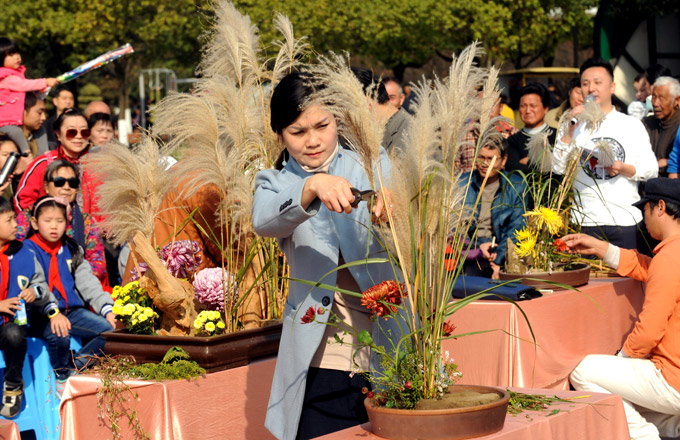

|
A train on the Baoji-Lanzhou railway in the northwestern province of Gansu. The Ministry of Railways plans to build a 56.45 billion yuan high-speed Baoji-Lanzhou rail line later this year. The new train will be able to go 350 km an hour. Asianewsphoto |
For tourists both from home and abroad, Gansu conjures up images from history and nature - the Silk Road, the Mogao Grottoes in Dunhuang, the Jiayuguan Pass (the western-most tip of the Great Wall) and the reclining Buddha in Zhangye.
History is still alive in the province, and in another five years you can travel on wheels from most parts of the country to have a brush with it.
Tourists now have to either fly or take the road to many of the tourist spots in Gansu. But with the Ministry of Railways clearing a project to lay 2,400 km of tracks, they can take a train ride (or two) to come face to face with history and nature,
Just like the Qinghai-Tibet Railway, which started operation in 2006, changed the economic and social landscape of southwest China, the nine new railway lines are expected to bring about a radical transformation in the northwest.
The central government had promised to make Lanzhou, provincial capital of Gansu, the gateway to the northwest. And its rail links with neighboring Sichuan, Qinghai and Shaanxi provinces, the Tibet and Xinjiang Uygur autonomous regions and the municipality of Chongqing in the next five years will make good that promise.
The 160-billion-yuan ($23.34 billion) railway project will link all of Gansu's 14 major cities, with Lanzhou being the center of the network.
Dunhuang in western Gansu is home to the Mogao Grottoes, Mingsha Shan (Echoing Sand Mountain), Crescent Moon Lake and the Yadan Landforms and many other historical and natural sites. It is by far the biggest tourist attraction in Gansu, and already has rail links with Lanzhou, Jiayuguan, Xian (capital of Shaanxi province) and Yinchuan (capital of neighboring Ningxia Hui autonomous region).
In the next five years it will be connected by rail (via Lanzhou) to Baoji in Shaanxi, Chengdu in Sichuan and Hezuo (capital of Gannan Tibetan prefecture in southern Gansu), Li Zhiyong, a senior official of the Gannan Prefecture Commission of Development and Reform, said recently.
Work on the Lanzhou-based railway project started late last year, and that on the Lanzhou-Urumqi (in Xinjiang), Lanzhou-Baoji and Lanzhou-Chengdu and Lanzhou-Hezuo lines will begin this year. The Lanzhou-Chengdu line will be linked with the Lanzhou-Chongqing, Baoji-Chengdu, Sichuan-Qinghai and Sichuan-Tibetan lines, construction of which will start this year, too.
That will not only give tourists a wider choice of getting a feel of China's vast and beautiful landscape, but also expedite transportation of goods to even remote areas. By 2015, Gansu will have a 5,700-km-long modern railway network, with the capacity to carry 800 million tons of goods, Li said.
Local officials said they would accelerate renovation work on old railway stations at the same time. "We have to upgrade our railway service because it's necessary for the environmentally friendly high-speed trains," said Wu Yuntian, director of Lanzhou Railway Bureau. "The railway network will undoubtedly expedite Gansu's economic growth and improve people's living standard."
Mao Shengwu, head of the Gannan, said the Lanzhou-Hezuo rail line would be a "sky route" for local residents. Gannan is located at the junction of Gansu, Qinghai and Sichuan provinces. But it is difficult to attract tourists to the beauty of its unique landscape and help develop the local economy because it does not have rail or air links with any city.
Gannan is home to the Maqu prairie and crystal clear lakes. "And raising cattle and sheep is still the main source of the people here," Mao said. The proposed rail link, however, will elevate it on the country's tourist map. "With speeds of up to 160 km an hour, the trains will be bringing in an increasing number of tourists to our prefecture," a Lanzhou-based newspaper quoted Mao as having said.
Listing the advantages of the proposed railway network, Li Xingjiang, professor of Northwest Normal University's College of Economic and Management, said people now pay 0.8 yuan per km to transport a ton of goods by road. Once the lines open the cost would come down to 0.1 to 0.15 yuan.
The network, however, is expected to give tourism a bigger boost because more than 60 percent of the 250,000-280,000 passengers traveling on the new route every year are expected to be tourists, the Ministry of Railways said.
Sichuan Governor Jiang Jufeng said the Lanzhou-Chengdu line would increase transport options between Northwest and Southwest China manifold. And since it will pass through Jiuzhaigou, a UNESCO World Cultural Heritage site, tourists can take a nature's tour.
Three sections of the new line will pass by the Minshan Mountains, home to giant pandas and other endangered animals and plants, offering tourists even more choices.
(China Daily 05/25/2009 page5)













